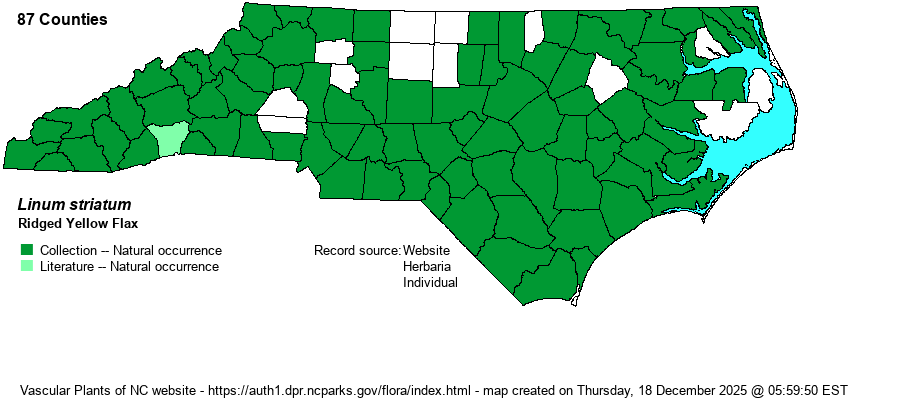| Author | Walter | |
| Distribution | Essentially statewide, though no collections from some central Piedmont counties.
This is an Eastern and Southeastern species, ranging from MA and MI south to northwestern FL and eastern TX. | |
| Abundance | Common in the Coastal Plain and adjacent Piedmont, fairly common to common in the Mountains, but infrequent to fairly common in much of the Piedmont. | |
| Habitat | This is a wetland species, growing in ditches, low woods, margins of lakes and ponds, and other sunny wetlands. Of the several Linum species in the Coastal Plain, this one grows more often in truly wet places, such as in rich and muddy soils, than the others. Several others, such as L. floridanum and L. intercursum, tend to be found in Coastal Plain wetlands only in acidic pinelands such as savannas and seepages. | |
| Phenology | Blooms and fruits from June to October. | |
| Identification | The Linum species are quite difficult to identify, especially as many of the former varieties and subspecies have now been elevated to full species. All are erect herbs to 1-2 feet tall, with slender branches that are usually ascending, small and narrow leaves, and numerous scattered small yellow flowers (with 5 petals) along the upper portions of the branches. L. striatum is the most distinctive of the NC species, as it has opposite or mostly opposite leaves, which are wider than in other species. The leaves are narrowly elliptical, as opposed to linear, and are about 1/5-inch wide, as opposed to 1/8-1/10-inch wide or less. Also, this species has ridged stems, as opposed to rounded. Lastly, this species has a paniculate inflorescence, whereas others are more corymbose; that is, there are short lower branches that contain some flowers, such that not all flowers are on branches that are somewhat equal in height from the ground (and yielding a flat-topped inflorescence). | |
| Taxonomic Comments | None
Website editors have received much help in species boundaries and in identification from Rogers (1963, 1984). | |
| Other Common Name(s) | Ridgestem Yellow Flax | |
| State Rank | S5 | |
| Global Rank | G5 | |
| State Status | | |
| US Status | | |
| USACE-agcp | FACW link |
| USACE-emp | FACW link |

